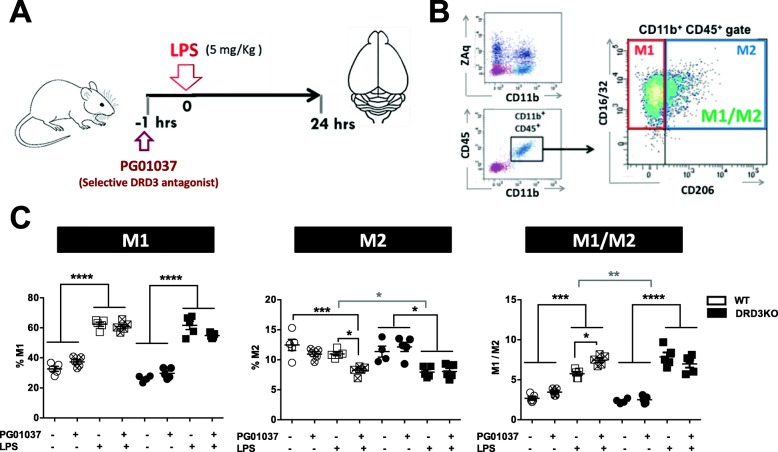Fig. 4.
Genetic deficiency or pharmacologic antagonism of DRD3-signalling attenuates the acquisition of M2-phenotype by microglial cells in the midbrain of mice undergoing systemic inflammation induced by LPS. Wild-type (WT) or DRD3 knockout (DRD3KO) mice were pre-treated or not with an i.p. injection of a DRD3-selective antagonist (PG01037; 30 mg/kg) and 1 h later received an i.p. injection of LPS (5 mg/kg) or PBS. Twenty-four hours after LPS administration, the midbrain/striatum structures were isolated, disaggregated, and M1 and M2 phenotypes were analysed in microglial cells by flow cytometry. a Schematic illustration of the experimental design. b Gating strategy used to analyse the M1 (CD16/32+CD206- cells) and M2 (CD16/32+CD206+ cells) phenotypes in living (ZAq−) microglial cells (CD11b+ CD45+). c Quantification of the frequencies of M1 (left panel) and M2 (middle panel) phenotypes and the M1-to-M2 ratio (right panel). Data from five mice per group is shown. Each symbol represents a WT (white) or a DRD3KO (black) animal. In each experimental group, the line and error bars represent the mean ± SEM, respectively. *p < 0.05; **p < 0.01; ***p < 0.001; ****p < 0.0001 by one-way ANOVA followed by Tukey’s post-hoc test. Black asterisks represent significant differences between treatments, whilst grey asterisks represent significant differences between genotypes

